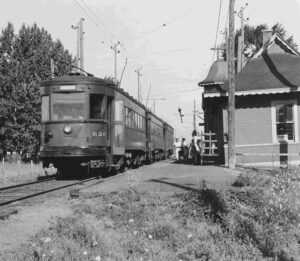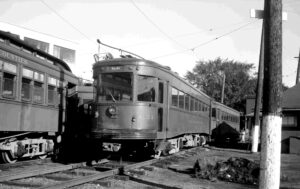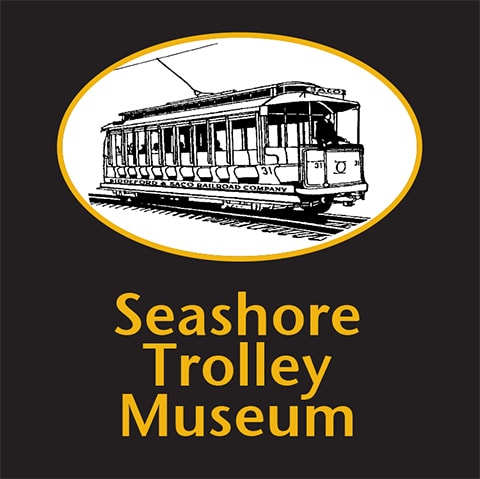
No 621’s sister No. 620 in 1950, source unknown; STM collection.
Operating History: The Windsor, Essex and Lake Shore Railway operated an interurban line between Windsor and Leamington, Ontario. When the line began operating at a loss, the municipalities along the line purchased the railway in 1929 in order to keep the service. Under new ownership, the WE&LS ordered five new cars believed to have been numbered in the 500 series. Ottawa Car Co. built these cars (four motor cars and one trailer) in 1930. Though somewhat heavier, the cars were Canadian versions of the high-speed lightweight interurbans of Ohio and Indiana such as Cedar Rapids & Iowa City No. 118 and Lehigh Valley Transit No. 1030 now at Seashore. These interurbans were early examples of streamlining. The WE&LS cars had 40 plush coach seats as well as 10 leather-upholstered chairs in a smoking compartment. They were lettered “The Sunshine County Route” with exteriors finished in blue with yellow trim.
The new, high-speed cars did not reverse losses on the WE&LS, and the company ended service in 1932. In 1938, the Montreal & Southern Counties Railway acquired four of the WE&LS high-speed cars, including one which became No. 621. M&SC applied a Pullman green paint scheme. The Montreal and Southern Counties was an interurban electric line built by the Grand Trunk Railway. It operated 47 miles between Montreal and Granby, Quebec. In Montreal, the M&SC shared tracks with streetcars of the Montreal Tramways Co. M&SC also had a short, suburban branch to Longueuil. The M&SC began operation in 1909. The interurban came under the control of the Canadian National Railways when the Grand Trunk became part of CNR in 1923. While No. 621 is a double-ended car, most M&SC cars were single end, coupled back to back in trains using a minimum of two cars. The M&SC shut down in 1956 after its tracks on the St. Lawrence River bridge at Montreal were converted to highway traffic. [See also: “Memories of the Montreal & Southern Counties,” The Dispatch, March 1996.]
Museum Ownership: When the M&SC converted the outer end of the Granby line to diesel in 1955, No. 621 became surplus. The CNR donated the car to Seashore. The CNR shipped the body of No. 621 on a flat car to Portland, while the trucks followed. A year later, the CNR also donated M&SC interurban coach No. 610 and freight motor No. 504 to the museum. Seashore has repaired various components of No. 621 including the roof, doors and mechanics. No. 621 operated often when it first came to Seashore. At that time, an inadequate 300 HP Sterling Viking II gasoline engine furnished the power. With the fuel virtually being sucked up through it, loud backfires were heard for miles away. Eventually, at least one motor developed a failure.
After the CNR donated No. 621 to Seashore, another CNR property, the Niagara, St. Catherines and Toronto, which operated around St. Catherines, Ontario, requested the 620 to 624 series cars (including No. 621) for further service on their line. The CNR asked Seashore if it would be willing to relinquish ownership of No. 621, but Seashore refused. So, the CNR sent the other four cars and a substitute fifth car of another type to the NS&T. Interurban service there lasted only a few more years, being abandoned in 1959. Requests from numerous trolley museums for cars from the NS&T fleet came in, but the NS&T refused them all, apparently not wanting to see their cars subject to deterioration if museums lacked the resources to care for them. Thus, the only reason that one of what was arguably Canada’s most modern interurban cars was preserved was the refusal by Seashore to let No. 621 go back into commercial service.
Current Condition: No. 621 has been out of service. Generally, it presents a “used” but fair appearance, having been stored under cover in Central Carhouse for some time.

No. 621 at St. Lambert Yard; Leo Sullivan collection.
 |
 |
 |
